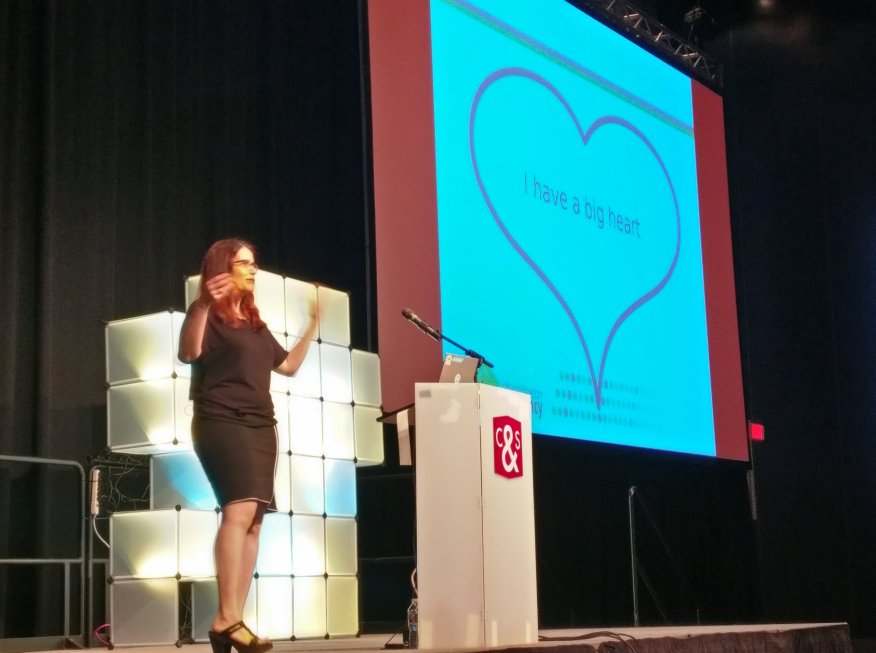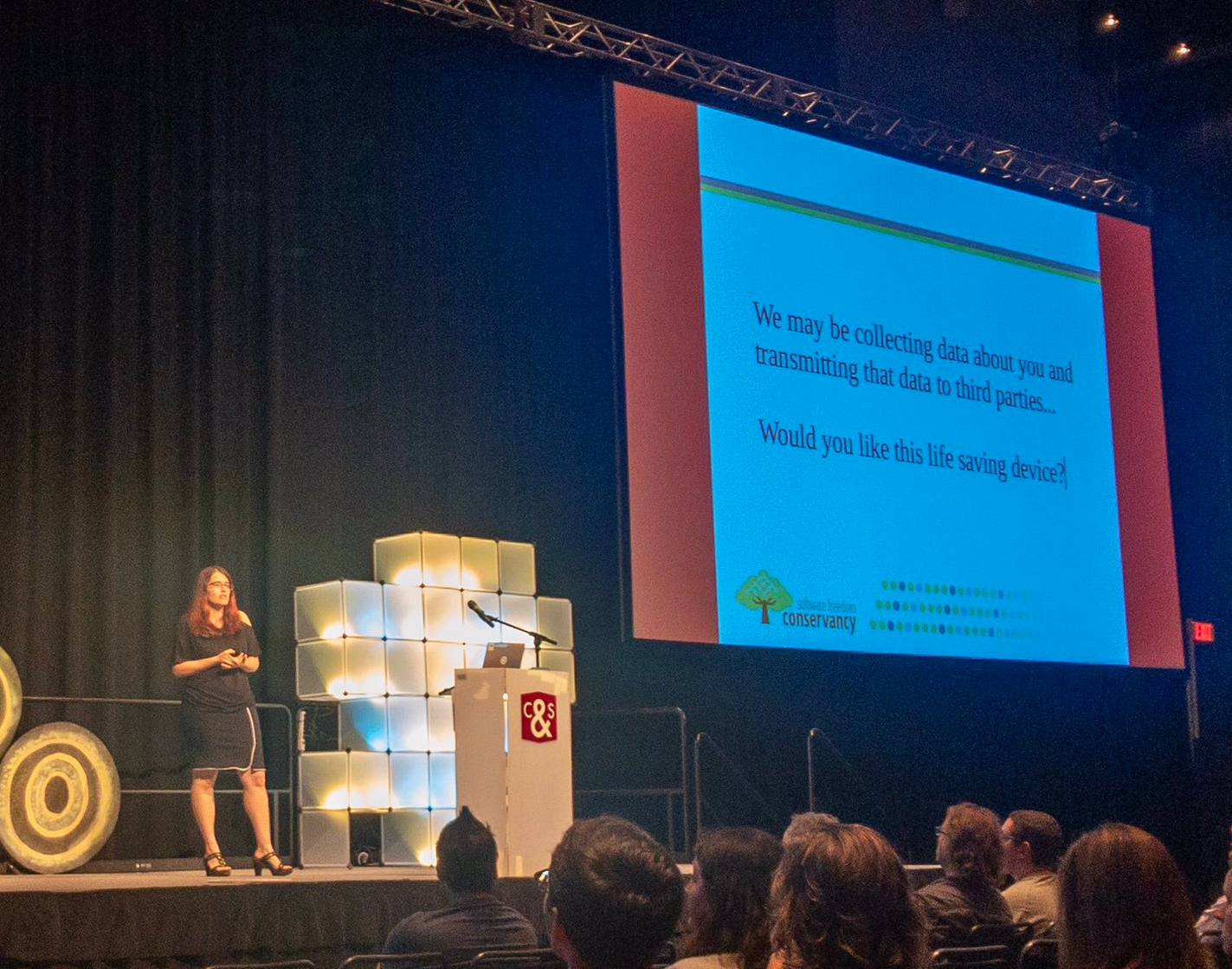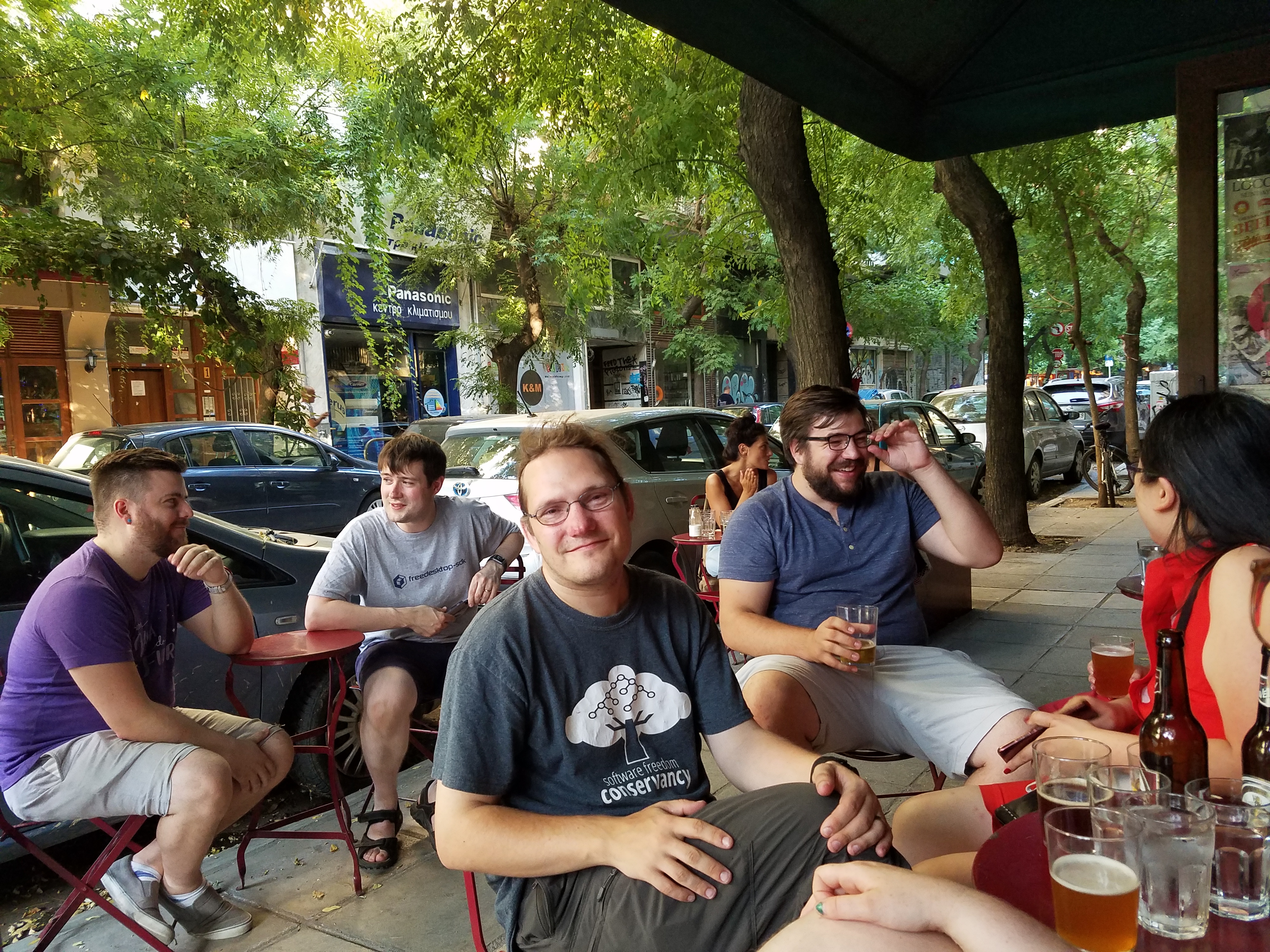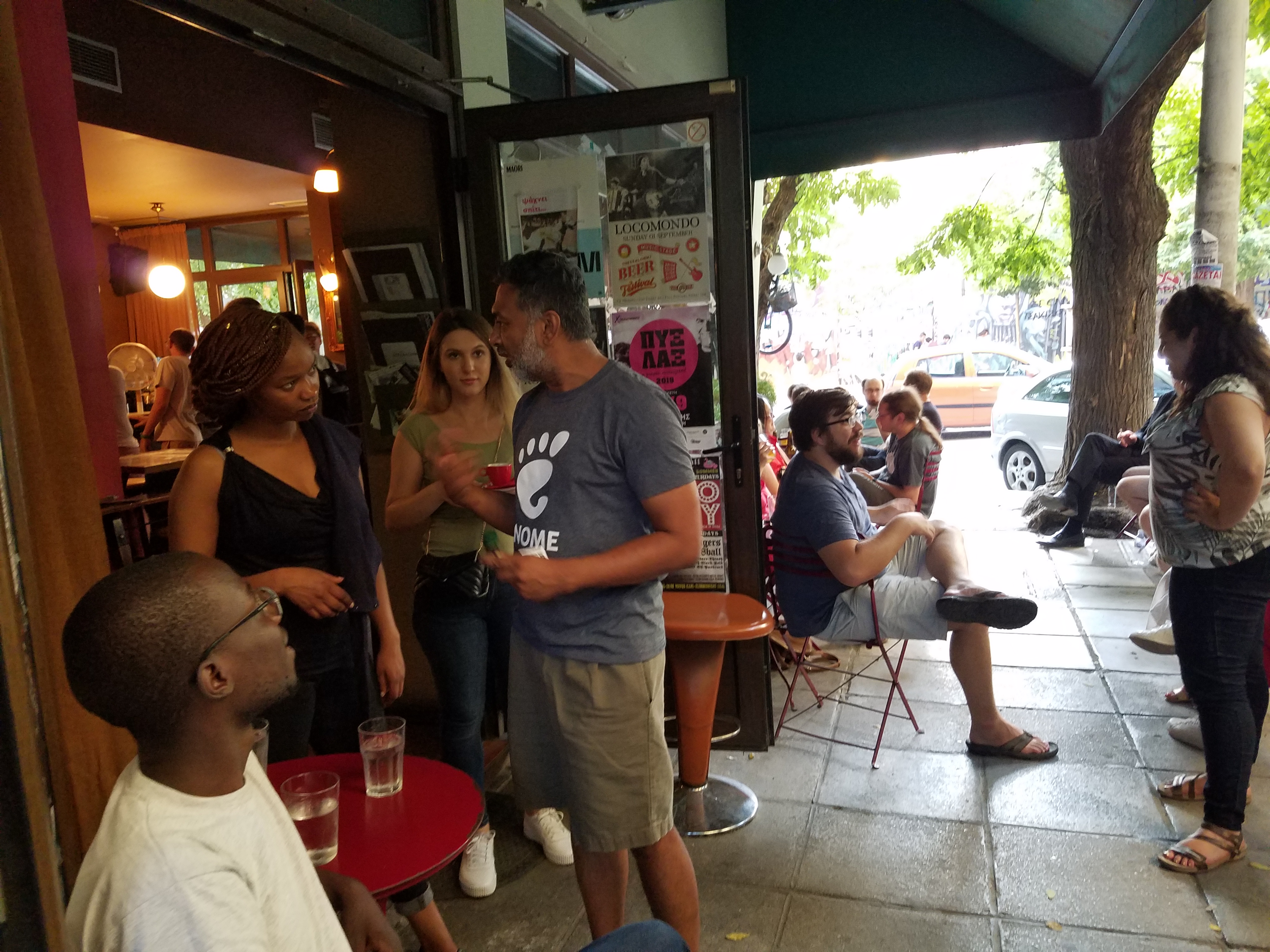![[RSS]](/static/img/feed-icon-14x14.2168a573d0d4.png) Conservancy Blog
Conservancy Blog
Displaying posts
tagged conservancy
![]()
Conservancy News Round-up August
by on September 11, 2019
Updates from many of our projects' departing summer interns, updates on what our contractors have been up to and pictures from recent events.

Picture is available under a CC.BY license and was taken by Sarah Withee

Picture is available under a CC.BY licenses and was taken by Zach Harris

Picture is available under a CC.BY.SA license and was taken by Deb Nicholson

Picture is available under a CC.BY.SA license and was taken by Deb Nicholson
Recent Videos and Pictures
Our Executive Director, Karen Sandler, is going to be part of an upcoming French documentary about the global fight for software freedom. The English version will be titled "Hackers For The Commons" and you can already check out the trailer (along with a fundraiser for the English version), right here. There are a few upcoming screenings scheduled of the French version.
Check out these two pictures from Karen's Abstractions talk last month! (top)
Deb held a "Supporters & Friends" event during GUADEC. Check out these nice pictures of folks talking about software freedom in Thessaloniki! (below)Upcoming talks from staff
Bradley is keynoting the 8th edition of Kernel Recipes in Paris on September 26 & 27. Conservancy is also this year's featured non-profit beneficiary. Registration opened this week.
Karen will be keynoting State of the Map in Heidelberg in September, on Saturday, September 21st.
Deb is speaking about "Selenium and Conservancy" at Selenium Conf this October.
Deb is also co-presenting with Nithya Ruff (the Head of Comcast’s Open Source Program Office) at All Things Open on "Companies and Communities: Why Can't We All Just Get Along?"
Interns are wrapping up for the summer
- Read this lovely wrap up from Niharika. titled: Last post!
- Plus this parting blog post from Priscillah, about her work on mUzima mobile.
- From Buildbot, Rajdeep Bharati reports on his Google Summer of Code work on MacPorts.
- Asami finishes his work adding QEMU/AArch64 Support to Coreboot
- A big omnibus report on Godot's eight GSoC students.
Also, applications are currently being accepted for the next round! Outreachy internships are remote, paid ($5,500 stipend), and last three months. Initial applications for the Dec 2019 to Mar 2020 internships are due on Sep 24 at 4pm UTC. Please help us reach folks who could benefit from an internship by sharing with your networks!
Conservancy contractors have been working hard
Lots happening at Reproducible Builds, including more work on diffoscope, new variations in their testing framework.
Over at phpMyAdmin, in addition to the intern that was sponsored directly through Conservancy, work focused on the request router and time with the Google Summer of Code interns who both wrapped up and reported on their work this summer, here and here.
Clojurists Together started work on four new projects. You can read about them all here.
Loads of fresh code!
- Wine 4.15 Released
- Git 2.23 Release Notes
- Boost Version 1.71.0
- Racket version 7.4 is now available
- You can try the new alpha Selenium IDE
- Lots of Linux XIA patches accepted
- QEMU version 4.1.0 released
- Twisted 19.7.0 Released
- Three new releases available from Evergreen!
- WebSocket updates, UDP multicast for Godot
- Samba 4.11.0rc3 Available for Download
- SWIG-4.0.1 released
Member Projects: Fall is for learning
- North Bay Python has tickets on sale now!
- Selenium Conf London also has tickets on sale now!
Thanks to Chris Lamby for promoting Conservancy with complimentary beer mats at the recent Debian BBQ!
Microsoft & exFAT: One Step on a Long Journey
by on August 30, 2019
In 2013, Conservancy helped resolve a GPL violation by Samsung which arose primarily due to complications around Microsoft's patent holdings related to the exFAT filesystem. At the time, Microsoft was known for demanding patent fees from Linux users and redistributors.
Late last year, Microsoft joined Open Invention Network. As we wrote at the time, this action had limited impact, as key patents like exFAT were not implemented in any packages that were part of OIN's “Linux System Definition”. We asked Microsoft at the time to upstream the exFAT code under GPLv2-or-later to confirm its intention to end patent aggression.
This week, in response to recent follow-up requests from upstream Linux developers, Microsoft announced that they would sign off on inclusion of exFAT in upstream Linux. This is the first step toward real patent peace related to exFAT.
This process for exFAT will only complete once all of the following happen: the exFAT patch appears in an official Linux release, that official Linux release becomes part of OIN's Linux System Definition (this generally happens automatically, as future versions of Linux are included by default), and Microsoft distributes a copy of Linux themselves that contains this technology. This last step is critical, as the OIN patent license is not as comprehensive as a full patent license from Microsoft. Any participating company can withdraw at any time from OIN1 (and there have been several withdrawals in the past, including Oracle, Facebook, HP and Symantec). After a transition period, the safety of OIN's non-aggression pact weakens. In contrast, when a company distributes software under the GPL, there is an irrevocable implicit patent license with the distribution, and GPLv2§7 further assures patent licensing safety.
Eventually, Microsoft will likely distribute a version of Linux containing exFAT to its Azure users and in its Windows Subsystem for Linux. However, until that occurs, the issue is not really resolved. An expedient solution is as we previously requested: that Microsoft bring definitive patent safety to free and open source software by publicly granting a permanent patent license for all patents Microsoft holds that read on Linux. Additionally, we invite Microsoft to keep pace with its peers such as Google and Red Hat, who years ago made very public patent promises to FOSS users. While the actions taken thus far are intermediary steps, I applaud Microsoft's journey from being a company that long attacked FOSS to becoming a contributor.
1 The legal mechanism for withdrawal is exercise of a “Limitation Election” in the OIN patent license agreement.
Conservancy News Round-up July
by on August 7, 2019
Plenty of code and free software discussion! This month we again have news from interns who are writing free software, plus lots of upcoming events with staff and several more put on by our member projects.
Recent Videos
Our Director of Community Operations, Deb Nicholson went to DebConf last month to connect with supporters and folks from member projects.
Deb also gave a talk on Free Software/Utopia.
Upcoming talks from staff
Our Executive Director, Karen Sandler, will be keynoting Abstractions on August 21-23 in Pittsburgh, PA.
Deb will keynote GUADEC at the end of the month in Thessaloniki, Greece. She’ll be talking about free software and utopia. While there, she’ll be holding a local Supporters meet-up later on Monday night at Elefantas at 6pm and sticking around for the open days to SpinachCon with GNOME projects on Tuesday.
Our Distinguished Technologist, Bradley M. Kuhn, is keynoting the 8th edition of Kernel Recipes in Paris on September 26 & 27. Conservancy is this year’s featured non-profit beneficiary. Registration opened this week.
Karen is also keynoting State of the Map in Heidelberg on Saturday, Septemebr 21st.
Outreachy: Interns are past the halfway point
-
Shraddhaag’s internship is with Fedora Happiness packets which includes working with a lot of new tech.
-
Nikki Sharpley is working on testing at Mozilla.
-
Priscillah has learned that tests and documentation take lots of time to do well, through her work on mUzima.
-
Carolina Jiménez Gómez wonders What’s after Outreachy?
GSoC students working on Conservancy projects this summer
-
jwgarber describes flashing a chip with Coreboot.
-
Four different Godot projects have news on their work this summer.
Code releases
Member Projects: Summer Work and Fall Plans
-
Clojurists Together is funding four projects over the next three months.
-
GodotCon and a Godot Sprint are planned in October. Come meet the Godot community in Poland this fall!
-
The North Bay Python CFP closes very soon, on August 9th!
-
What Reproducible Builds got up to in July.
-
Tickets are available now for SeleniumConf in London this October.
-
Teaching Open Source held a sprint to develop FOSS courses.
Conservancy News Round-up June
by on June 28, 2019
Summer in the northern hemisphere means lots and lots of busy time with interns and quite a few FOSS events. We've got plenty of blog posts for your edifying summer reading and plenty of opportunities to catch up with Conservancy folks in person.
Recent Podcast
New FAIFcast episode: Bradley and Karen enjoy and discuss Molly De Blanc's keynote at the first annual CopyleftConf, entitled The Margins of Software Freedom, followed by an exclusive interview with Molly! This show was released on May 31st, 2019.
OSCON in Portland next month
We've got our pub night, two talks by staff and two days of expo floor. We hope to see you there!
Monday, July 15th
Join us from 7pm -10pm at McMenamin's Broadway Pub! The address is 1504 NE Broadway St, and it's about a 20 minute walk (or an 11 minute bus ride) from the Oregon Convention Center. Deb and Bradley will be there to meet with Supporters and to talk about software freedom! There is nothing we'd like more than to spend an evening talking about the future of free software and its toughest problems with supporters and friends. Light snacks will be provided.Expo Hall Hours
- Wednesday, July 17: 10:15am – 5:45pm / 5:45pm – 7:00pm (Sponsor Reception)
- Thursday, July 18: 10:15am – 4:15pm
Volunteers are essential to the success of a booth at a large event like OSCON. Let us know if you can help out by committing to a few hours of booth time. We'd really appreciate it!
Wednesday, July 17
Deb Nicholson, "FOSS governance: The good, the bad, and the ugly" at 2:35pm–3:15pmThursday, July 18
Bradley Kuhn, "If open source isn't sustainable, maybe software freedom is?" at 1:45pm–2:25pmMore upcoming talks from staff
Bradley Kuhn, our Distinguished Technologist will be at the Ninth Annual RacketCon in Salt Lake City, Utah, on July 13 & 14, where he will give a talk titled, "Conservancy and Racket: What We Can Do Together!"
The 20th Debian Conference will be held in Curitiba, Brazil, from July 21st to 28th, 2019. Our Director of Community Operations, Deb Nicholson is giving two talks there and will be around for formal and informal discussions.
Deb is also speaking at the Mid-Atlantic Developer Conference on August 1st.
Our Executive Director, Karen Sandler, will be a featured speaker at Abstractions on August 21-23, 2019 in Pittsburgh, PA
Bradley is keynoting the 8th edition of Kernel Recipes in Paris on September 26 & 27. Conservancy is this year's featured non-profit beneficiary. Registration opened this week.
Outreachy: Blogs from this year's amazing interns
- The Mercurial Commands That Saved My Workflow By Danielle Leblanc-Cyr
- Outreachy : Understanding my project and contributing to Mozilla by Nupur Baghel
- Let’s talk mUzima by Priscillah
- Outreachy Week 5: What is debci? by Candy Tsai
- Outreachy Internship: Improve suricata-update by Vagisha Gupta
- Jaegertracing in Ceph 101 and my struggles till now by deepika
GSoC students are also working on Conservancy projects this summer
- Ghidra firmware utilities, week 5 by Asami (at Coreboot)
- Google Summer of Code ’19 With phpMyAdmin by Apoorv Khare
Even more code!
- Backdrop 1.13 Released
- BusyBox 1.31.0 (unstable)
- Security fix: phpMyAdmin 4.9.0 is released
- Samba 4.10.5 Available for Download
- Twisted 19.2.1 Released
- Wine 4.11 Released
Our Member Projects Have Been Busy
- Reproducible Builds in May 2019
- WebRTC support, progress report #3, includes tutorials, demos and a peek at future work.
- Homebrew shared some nice pictures from their first-ever maintainers meeting!
Next page (older) » « Previous page (newer)
1 2 3 4 5 6 7 8 9 10 11 12 13 14 15 [16] 17 18 19 20 21 22 23 24 25 26 27 28 29 30 31 32 33 34 35 36 37 38 39 40 41 42 43 44 45 46 47 48 49 50 51 52
